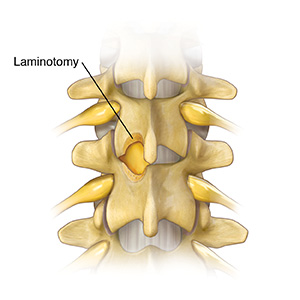Laminotomy
Laminotomy is a surgery that removes a small amount of bone from the spine. This takes pressure off nerves in the low back, which reduces symptoms. These surgeries are not cure-alls, but they are especially good at reducing leg pain.
 |
| Part of the lamina is removed from the vertebra above and below the pinched nerve. |
Before your surgery
You will most likely arrive at the hospital on the morning of the surgery. Be sure to follow all of your provider's instructions on preparing for surgery:
-
Follow any directions you are given for not eating or drinking before surgery.
-
If you take a daily medicine, ask if you should still take it the morning of surgery.
-
If you take any blood-thinning medicine, such as aspirin, Plavix (clopidogrel), or Coumadin (warfarin), you should discuss them in great detail with your doctor at least a week in advance.
-
At the hospital, your temperature, pulse, breathing, and blood pressure will be checked.
-
An intravenous (IV) line will be started to provide fluids and medicines needed during surgery.
During your surgery
-
Once in the operating room, you will be given anesthesia.
-
After you are asleep, an incision is made near the center of your low back. It may be 2 to 6 inches long, depending on how many vertebrae are involved.
-
During a laminotomy, part of the lamina (bone that forms the back of the spinal canal) is removed from the vertebra above and below the pinched nerve. The small opening created is sometimes enough to take pressure off the nerve. However, in most cases, disk matter or a bone spur that is pressing on the nerve is also removed.
-
Once the nerve is free of pressure, the incision is closed with stitches or surgical staples.
After your surgery
-
After surgery, you will either go to the post anesthesia care unit (PACU), recovery room or directly to your room from the operating room.
-
If you are in the PACU, you will be moved to your room after you wake up.
-
You may stay the night or you may go home later in the day after surgery.
-
You will receive medicine to ease your pain or discomfort.
-
You may also have a small tube called a catheter to drain your bladder.
-
Healthcare providers will get you up and moving soon after your surgery.
-
You will also be shown how to keep your lungs clear.
|
When to contact your healthcare provider
Once at home, call your doctor if you have any of the symptoms below:
· Unusual redness, heat, or drainage at the incision site
· Increasing pain, numbness, or weakness in your leg
· Fever over 100.4°F (38°C)
· Swelling, warmth, or pain in your calf
|